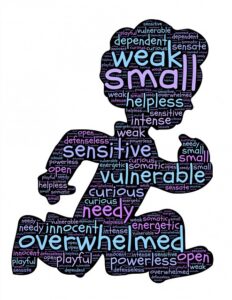Are you tired of feeling like you have to keep up a facade of strength and invulnerability? Do you long to be able to let your guard down and connect with others on a deeper level? It’s understandable to feel scared of being vulnerable – after all, it means opening yourself up to the possibility of rejection and hurt.
But avoiding vulnerability can also prevent you from experiencing the richness and intimacy that comes with authentic connection.
In this article, we’ll explore some strategies for overcoming your fear of vulnerability. We’ll start by delving into the roots of this fear, helping you understand where it comes from and why it’s so hard to shake. Then, we’ll guide you through some exercises for cultivating self-awareness and building trust with others. Finally, we’ll offer tips for practicing vulnerability in small steps, so you can gradually become more comfortable with opening up.
By the end of this article, you’ll be well on your way to embracing the rewards of vulnerability and living a more authentic, connected life.
Understanding the Roots of Fear
 Exploring the underlying reasons for our fear can help us better understand and overcome our hesitations towards emotional openness. One reason why we fear vulnerability is because we might not want to appear weak or be judged by others. We may have been conditioned by society to believe that vulnerability is a flaw, when in reality, it’s a powerful form of strength.
Exploring the underlying reasons for our fear can help us better understand and overcome our hesitations towards emotional openness. One reason why we fear vulnerability is because we might not want to appear weak or be judged by others. We may have been conditioned by society to believe that vulnerability is a flaw, when in reality, it’s a powerful form of strength.
Another factor that contributes to our fear of vulnerability is our past experiences. Perhaps we’ve been hurt in the past by someone we trusted, causing us to build walls around ourselves to protect our emotions. However, it’s important to recognize that vulnerability is not synonymous with weakness. It takes courage to open up and share our true selves with others.
Overcoming societal conditioning and exploring vulnerability triggers can help us to overcome our fear of being vulnerable. By examining our beliefs and attitudes towards vulnerability, we can start to challenge them and replace them with more positive and empowering ones.
We can also identify the situations and people who trigger our fears and work on strategies to manage them. In doing so, we can become more comfortable with being vulnerable and develop deeper, more meaningful connections with others.
Cultivating Self-Awareness
By practicing self-awareness, you can better understand and embrace your emotions, leading you to feel more comfortable expressing yourself authentically. Cultivating self-awareness involves taking time for self-reflection and mindfulness techniques.
Here are some ways to start:
1. Journaling: Writing down your thoughts and feelings can help you process and understand them better. You may find patterns or triggers that cause vulnerability, which can help you prepare for those situations in the future.
2. Mindful breathing: Taking deep breaths and focusing on your breath can help you stay present and calm, reducing anxiety and fear. This technique can be especially helpful when faced with situations that make you feel vulnerable.
3. Mindful body scan: Paying attention to your body, noticing any sensations or tension can help you identify where you may be holding onto emotions or fears. This technique can help you release those emotions and feel more grounded.
4. Seeking therapy: A therapist can provide a safe and supportive space for you to explore your emotions and work through any fears or vulnerabilities you may have.
Remember, vulnerability is a natural part of being human, and it takes courage to express ourselves authentically. By cultivating self-awareness, you can learn to embrace your emotions and let go of fear, leading to a more fulfilling and connected life.
Building Trust with Others
Building trust with others is crucial for creating meaningful connections and achieving personal growth. When it comes to vulnerability, having a support system of trustworthy individuals can make all the difference. Effective communication is key to building trust, and it involves actively listening to others, expressing oneself clearly, and being receptive to feedback. By doing so, you’ll create an environment where honesty and vulnerability are valued.
Empathy and compassion are also essential components of building trust. To be vulnerable, you need to feel safe and understood. When you show empathy and compassion towards others, you’re more likely to receive it in return. It’s important to remember that everyone has their own struggles and experiences, and by acknowledging and validating those feelings, you’ll create a deeper connection with others.
Building trust with others takes time and effort, but it’s worth it. When you feel supported and accepted, you’ll be more likely to take risks and be vulnerable. By practicing effective communication and showing empathy and compassion towards others, you’ll create an environment where vulnerability is celebrated, and personal growth can flourish.
Remember, vulnerability isn’t a weakness, but a strength that allows for deeper connections and personal growth.
Practicing Vulnerability in Small Steps
You can start practicing vulnerability in small steps by taking the time to reflect on your emotions and sharing them with someone you trust. Journaling exercises can be helpful in this process, allowing you to explore your thoughts and feelings in a safe and private space.
By becoming more aware of your emotions, you can learn to express them more openly and authentically with others. It’s important to seek support when practicing vulnerability. This can mean finding a therapist or counselor to talk to or simply confiding in a friend or family member who you feel comfortable with.
Building a support system can help you feel more confident in your ability to be vulnerable and can provide a safety net for when things feel overwhelming. Remember that vulnerability is a process and it’s okay to take small steps at a time.
By practicing vulnerability in small ways, you can gradually build up your ability to be more open and authentic with others. It takes courage to let yourself be vulnerable, but the rewards can be immense – deeper connections, greater emotional intimacy, and a sense of personal growth and self-awareness.
Embracing the Rewards of Vulnerability
Embracing vulnerability can lead to a more fulfilling life full of deeper connections and personal growth. It may be scary to let your guard down and expose your innermost thoughts and feelings, but the rewards can be tremendous.
By acknowledging and accepting your vulnerability, you open yourself up to new experiences and opportunities for growth. You may find that your relationships become deeper and more meaningful, as you allow others to see the real you.
Despite the importance of vulnerability, our society often stigmatizes it as a weakness. We’re taught to put on a brave face and hide any signs of vulnerability, which can lead to feelings of shame and inadequacy. However, it’s important to remember that vulnerability is not a weakness, but rather a strength. It takes courage to be vulnerable, and by showing your vulnerability, you’re demonstrating your authenticity and honesty.
Overcoming societal stigmas and embracing vulnerability can be a difficult journey, but the rewards are worth it. You may find that you’re better able to connect with others and form more meaningful relationships. You may also experience personal growth and become more confident in yourself and your abilities.
So, take a deep breath and allow yourself to be vulnerable. The possibilities for growth and connection are endless.
How can I differentiate between healthy vulnerability and oversharing?
To differentiate between healthy vulnerability and oversharing, it’s important to set boundaries and build trust in your relationships.
Healthy vulnerability involves sharing your feelings and experiences in a way that feels safe and respectful to yourself and others. It’s about being open and honest without crossing the line into TMI territory.
Setting boundaries means knowing your limits and communicating them clearly to others. Building trust involves being consistent, reliable, and respectful in your interactions with others.
When you feel secure in your relationships, it’s easier to be vulnerable in a healthy way. Remember that vulnerability is a strength, not a weakness, and it can deepen your connections with others.
What if I have been hurt in the past and am afraid to be vulnerable again?
Picture yourself standing at the edge of a cliff, looking out at the vast expanse of the world before you. You know that taking that first step forward means taking a risk, but it also means embarking on an incredible journey.
Overcoming fear is never easy, especially when you’ve been hurt in the past. But building trust with others and allowing yourself to be vulnerable can be one of the most rewarding experiences of your life. It takes courage to open up, but it also takes strength to recognize when it’s safe to do so.
Take small steps, surround yourself with supportive people, and remember that every moment of vulnerability is an opportunity for growth and connection. You’re worthy of love and belonging, and the more you allow yourself to be vulnerable, the more you’ll receive it in return.
Is vulnerability always necessary in building strong relationships?
Building strong relationships requires a level of vulnerability that can be uncomfortable for many people. While it may not always be necessary, vulnerability is an important tool for building trust and personal growth.
It allows you to share your feelings and experiences with others, creating deeper connections and understanding. However, being vulnerable can also be scary, especially if you’ve been hurt in the past.
It’s important to remember that vulnerability is a choice and you can always set boundaries to protect yourself. By taking small steps and opening up gradually, you can start to build trust and create meaningful relationships.
Don’t be afraid to seek support from others as you navigate the challenges of vulnerability. Remember, it takes courage to be vulnerable, but the rewards are worth it.
Can vulnerability be practiced in professional settings, such as the workplace?
In professional settings, vulnerability can be both beneficial and challenging. Sharing your weaknesses and struggles with colleagues can foster deeper connections and trust, leading to a more collaborative and supportive work environment.
However, there are also potential drawbacks, such as the risk of judgment or negative consequences from sharing too much. For example, if you’re a leader and share your vulnerabilities, it may affect your team’s perception of your ability to lead effectively.
It’s important to find a balance and use discernment when practicing vulnerability in the workplace. Some case studies show that leaders who are vulnerable and open about their struggles often inspire their team to work harder and be more invested in the company’s success.
Ultimately, vulnerability can be practiced in professional settings, but it requires careful consideration of the benefits and drawbacks, as well as good judgment and discernment.
How can I handle rejection or negative reactions when I am vulnerable with someone?
Establishing boundaries and building trust are key components to handling rejection or negative reactions when being vulnerable with someone.
Just like a ship needs a solid anchor to weather a storm, you need to establish clear boundaries in your relationships to protect yourself while remaining open and vulnerable.
Building trust takes time and effort, but it’s essential for creating a safe space where you can express yourself without fear of judgment or rejection.
Remember, vulnerability isn’t weakness, but rather a strength that allows you to connect with others on a deeper level.
So, take a deep breath, set your boundaries, and let yourself be vulnerable. You might be surprised at the positive reactions you receive when you open up and show your true self.
You now know how to stop being scared of being vulnerable. It’s a process that takes time and effort, so it’s okay to take small steps and go at your own pace.
The rewards of vulnerability are immense. You’ll connect with others on a deeper level, build stronger relationships, and feel more fulfilled. So don’t be afraid to let your guard down and show your true self.
You’re worthy of love and acceptance just as you are. Keep cultivating self-awareness, building trust with others, and practicing vulnerability in small steps. You’ve got this!





